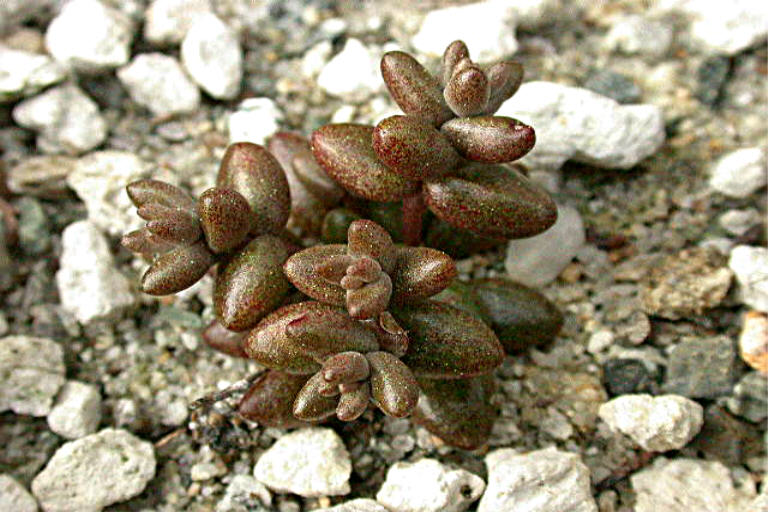Corms elongate and uncormlike, 1.5-3.5 cm × 1-6 mm. Leaves 5-15, (often buried in soil except for adaxial surface of each leaf blade, rarely clavate, mostly sharply divided into blade and petiole, 7-15 mm); petiole 3-10 mm wide, to 1/7 as wide as blade; blade yellow-green, ovate to orbiculate or reniform, 0.2-0.7 cm × 2-7 mm, 2-4 mm thick, base 1-2 mm wide, apex rounded (margins often subglobular), surfaces somewhat glaucous. Inflorescences: cincinni 3-10-flowered, 1-4 cm; floral shoots 2-11 cm × 0.5-1 mm at base, to 2.5 mm wide near middle; leaves 10-20, spreading, blade triangular-ovate to suborbiculate or reniform, 0.2-1 cm × 2.5-8 mm, 2-6 mm thick, apex obtuse. Flowers with musky, sweet odor; petals connate 0.7 mm, spreading from near middle, white, pinkish on keel and yellowish toward base, often red-lineolate, elliptic, 5-8.5 × 2-3.5 mm, apex subobtuse, corolla 8-15 mm diam.; pistils connivent or separate, erect at anthesis; ovary 2-4 mm; styles 1-1.5 mm. Follicles widespreading, adaxial margins nearly horizontal. 2n = 34.
Flowering spring. Thin, sandy soil on mesas; of conservation concern; 100 m; Calif.
Dudleya brevifolia is rare and grows in thin, sandy soil strewn with small, reddish brown iron concretions, on reddish sandstone capping the Linda Vista Terrace in western San Diego County, as at Torrey Pines State Park. Usually, it is in openings in the chaparral nearly bare of other plants. Even within this unique habitat, the colonies are few and local, not found in seemingly identical places nearby. At one place, it grew formerly in depressions in the mesa, crowded together in a sod of Selaginella cinerascens A. A. Eaton, with Crassula connata. Although reported from seven places, it is evidently extinct at some because of urbanization; it is considered seriously threatened (California Native Plant Society, http://cnps.web.aplus.net/cgi-bin/inv/inventory.cgi).
Dudleya brevifolia shows the ultimate in leaf reduction within the genus, having the smallest leaves and of the most divergent and remarkable leaf type. M. Dodero (1996) noted that it is paedomorphic, retaining in adult leaves the form seen throughout the subgenus in juvenile leaves. It hybridizes in nature with D. edulis (R. V. Moran 1951).
Dudleya brevifolia is in the Center for Plant Conservation´s National Collection of Endangered Plants.




